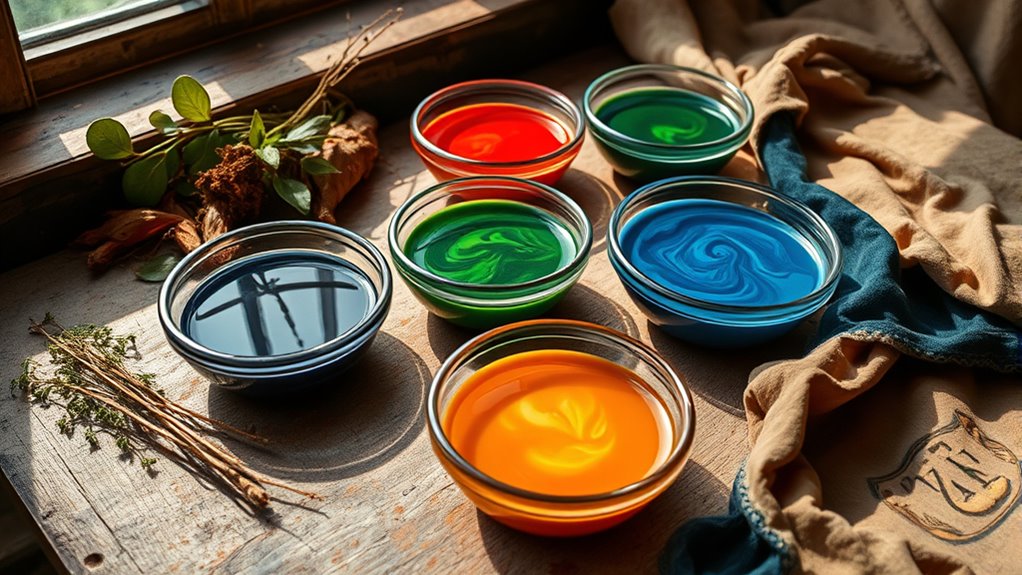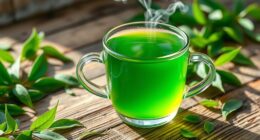To color fabrics with plants and food, you first extract pigments by chopping, boiling, or steeping plant materials like berries, leaves, or roots. Then, immerse your fabric into the dye bath, often after mordanting with substances like alum or iron to enhance color and durability. Longer soaking or multiple dips deepen the hues. Experimenting with different plant sources and mordants can create unique shades—continue exploring to discover how natural dyes can transform your textiles creatively and sustainably.
Key Takeaways
- Natural dyeing uses plant and food sources to color fabrics sustainably, producing vibrant, eco-friendly hues.
- Extract pigments by boiling or steeping plant parts like berries, leaves, or roots before immersing fabric.
- Mordants such as alum or iron enhance dye adhesion and durability, affecting final color shades.
- Fabric is pre-washed and mordanted if needed, then soaked or dipped multiple times for richer colors.
- Proper safety measures are essential, as some mordants and plant materials may be toxic or require careful handling.

Have you ever wondered how to add vibrant color to textiles without relying on synthetic dyes? Natural dyeing offers a sustainable and creative way to infuse fabrics with rich hues derived directly from plants and food. The process begins with plant extraction, where you carefully boil or steep plant materials—such as berries, leaves, roots, or bark—to release their pigments. This step is essential because it determines the intensity and shade of your final color. Once you’ve extracted the dye, you’ll often need to enhance or fix the color using mordant techniques. Mordants are substances that help the dye adhere better to the fabric, resulting in more vivid, lasting colors. Common mordants include alum, iron, and tannin, each producing different effects and shades.
When working with plant extraction, it’s important to choose the right plant materials based on the color you desire. For example, madder root yields a deep red, while indigo produces blue. You start by chopping or crushing your chosen plant parts and boiling them in water for a period, often between 30 minutes and an hour. This simmering releases the pigment into the water, creating your dye bath. Strain out the plant matter, and then immerse your fabric—usually pre-washed and mordanted if necessary—into the dye bath. The longer the fabric sits, the more intense the color becomes. Keep in mind that some plant dyes require multiple dips or longer soaking times to achieve the desired vibrancy.
Mordant techniques are essential because they influence both the color outcome and the durability of the dye. To prepare your fabric, you submerge it in a mordant solution beforehand, which acts as a chemical anchor for the pigment. Alum mordant is popular for bright, true-to-nature colors, while iron can deepen shades or create more muted tones. Tannins, found naturally in tea or oak bark, can be used alone or with other mordants to produce a wide range of hues. Experimenting with different mordants allows you to customize your color palette and achieve complex, nuanced shades. Always follow safety guidelines when handling mordants, as some can be toxic if not used properly.
Frequently Asked Questions
How Long Do Natural Dyes Typically Last on Fabrics?
Natural dyes typically last several years on fabrics, but fading resistance varies based on factors like exposure to sunlight and washing. To maintain vibrant colors, you should follow proper maintenance tips, such as washing in cold water, avoiding harsh detergents, and storing fabrics away from direct sunlight. These steps help extend the life of your natural dyes, ensuring your colorful creations stay beautiful longer.
Can Natural Dyes Be Used on Synthetic Fabrics?
You can use natural dyes on synthetic fabrics, but be aware of synthetic fabric compatibility issues. Synthetic fibers often have different dye absorption differences compared to natural fibers, making it harder for the dyes to bond effectively. To achieve vibrant, lasting colors, you might need to pre-treat the fabric or use mordants. Testing small samples first helps determine how well the dye adheres to your synthetic material.
Are There Safety Concerns When Handling Plant-Based Dyes?
Sure, handling plant-based dyes is totally safe—if you’re okay with risking skin sensitivity reactions and dodging toxic plant compounds. You might get a rash or worse if you’re not careful. So, wear gloves, work in well-ventilated areas, and wash your hands afterward. Think of it as a wild adventure in safety, where your biggest danger is a colorful stain on your clothes—unless you’re allergic.
How Do Climate and Water Quality Affect Dye Results?
Climate impact and water quality profoundly influence your dye results. Warmer climates can intensify plant growth, leading to richer dye extracts, while cooler or variable weather might produce duller colors. Poor water quality, with high mineral content or pollutants, can alter dye absorption, resulting in uneven or dull hues. To get consistent results, consider the climate impact and use clean, high-quality water for your dyeing processes.
Can Natural Dyes Be Color Fast Without Chemical Mordants?
Think of natural dyes like a handshake—trust needs to be built. Without chemical mordants, plant mordants like alum or tannins can help lock in color, making it more dye stable and resistant to fading. While some dyes may fade over time, proper pre-treatment and mordant use can often achieve good color fastness naturally. So, yes, you can get decent durability without chemicals, but understanding plant mordants is key.
Conclusion
You now hold the key to transforming everyday fabrics into vibrant works of art using nature’s palette. Just like a garden blooms with hidden beauty, your newfound knowledge allows you to unveil the secret hues lurking in plants and food. Embrace this craft as a journey of discovery, where each dye bath is a step closer to creating a tapestry woven from the earth’s own colors. Let your creativity blossom like a wildflower in spring.









